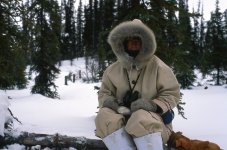Kathleen and I fell in love with the Canada’s northern landscape after canoeing the South Nahanni River (1990), the Thelon River (1993), the Coppermine River (1995) and the Seal River (1997). We thought we might want to move to the Northwest Territories. But I had grown up in Sacramento, and moved to Vancouver, British Columbia in 1975. Kathleen had spent all but the first two years of her life in Vancouver. The Northwest Territories has a long winter, and we had virtually no experience of living in, and working in cold weather. So before making such a major move we concluded that we should try living in the Northwest Territories for at least part of a winter. You might have read about our experience on
canoetripping.net in the winter camping forum under the topic “Our Winter of Content in Canada’s Western Arctic. We lived in a one-room cabin, 100 km (60 miles) north of the Arctic Circle from January 31 until breakup in mid June.
To prepare ourselves for this adventure, we bought the book by Garrett and Alexandra Conover,
A Snow Walker’s Companion: Winter Trail Skills From the Far North. I expect that some of you will disagree with their perspective that “Synthetic clothing is junk. It begins as junk, and it stays junk all the way to the landfill. It is, in fact, a double negative. It wears out readily, yet it may never decompose once discarded.”
In fact, we obtained most of our winter clothing quite inexpensively, primarily because, like the Conovers, we prefer wool. Like many modern synthetic materials, wool breathes well and retains heat, even when wet. Unlike synthetics such as fleece, however, wool is easily repaired in the field, and does not ‘melt’ when contacted by heat or campfire embers . Several trips to the various thrift and army surplus stores provided all we needed in the way of wool pants, wool shirts and wool sweaters. We purchased medium and heavy sets of wool long underwear, both top and bottom, at the Army & Navy, Vancouver’s most ‘blue collar’ department store.
We were especially intrigued with the Conovers’ recommendation for footwear: “The [traditional] sock-felt-moccasin system is entirely breathable, very lightweight, and magnificently functional in conditions ranging from twenty-five degrees Fahrenheit [minus 4 degrees C] to as cold as temperatures go on earth. [The system] is comfortable and light as can be. You feel as if you are prancing around in bedroom slippers.”
The Conovers provided a contact for where we could buy such footwear, also known as mukluks. In fact, we purchased much of our winter gear from Craig McDonald, in Dwight, Ontario. We ordered four pairs of mukluks, with light canvas uppers and tanned moosehide bottoms. Our friend in Inuvik recommended that we make our own duffel-cloth liners for our mukluks: “They are simple to make. Since Kathleen sews she could easily make them to fit your mukluks. As you know, patterns are available in the Conover book.” That’s what we did, and we still use our mukluks more than 20 years later, as they are pretty much good as new. In fact, we look forward to winter just for the thrill of prancing about in the snow in our mukluk bedroom slippers.
We also bought wind suits, made of light canvas, as windbreaks. The Conover book advised that fur ruffs, which are much warmer than synthetic materials, should always be added to wind suits. Where would we get coyote ruffs in Vancouver? I inquired at MEC. Not surprisingly, they did not carry any kind of fur. Our friend in Inuvik suggested that we call the Winnipeg Fur Exchange. Their catalogue said they were open 24 hours a day. That intrigued me. As a test, I drank brandy until midnight, and made the call. After only one ring, a voice on the phone said, “Winnipeg Fur Exchange. How may I help you?” As soon as the the fur ruffs arrived, Kathleen easily sewed them onto our canvas wind suits.
Now I have reached the point of why I am posting this. Our experience with these ruffs is exactly like that of yellowcanoe.
And I love my coyote ruff on my Arctic Anorak ( cotton). Seems to keep the warm air in that I am breathing.

From Kathleen’s diary on March 28:
Even though we're warm while moving, we cool off quickly when we stop for lunch. I’m quite impressed at what a difference the fur ruff makes. Even in a strong wind, the air around my face stays warm.
